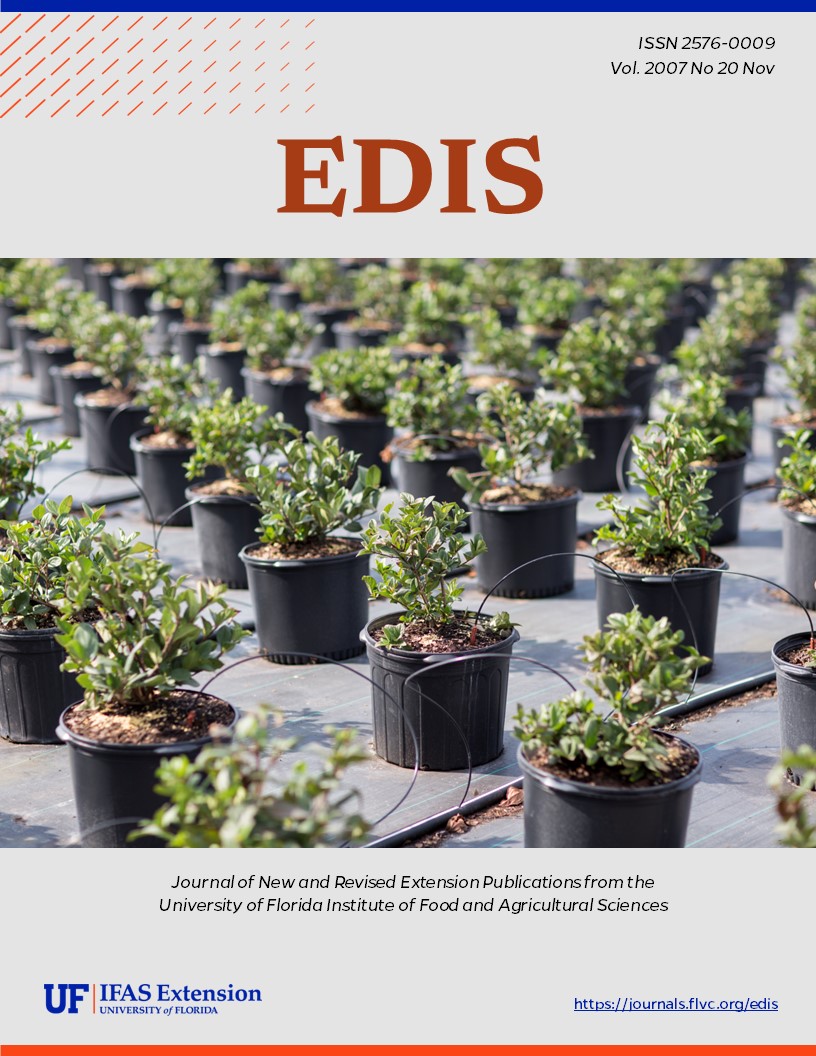Abstract
SS-AGR-285,a 7-page illustrated fact sheet by Robert A. Gilbert,James M. Shine, Jr., and Ronald W. Rice,is part of the Sugarcane Handbook.It reports the results of a series of experiments that were designed to compare and contrast relative sugarcane cultivar performance at different locations throughout the Everglades Agricultural Area (EAA).Includes references.Published by the UF Department of Agronomy,October 2007.
References
Alvarez, J.A., D.R. Crane, T.H. Spreen and G. Kidder. 1982. A yield prediction model for Florida sugarcane. Agric. Syst. 9:161-179. https://doi.org/10.1016/0308-521X(82)90018-X
Arceneaux, G. and L.P. Hebert. 1943. A statistical analysis of varietal yields of sugarcane obtained over a period of years. Agron. J. 35:148-160. https://doi.org/10.2134/agronj1943.00021962003500020008x
Bissessur, D., R.A.E. Tilney-Bassett, L.C.Y. Lim Shin Chong, R. Domaingue, and M.H.R. Julien. 2000. Family x environment and genotype x environment interactions for sugarcane across two contrasting marginal environments in Mauritius. Expl. Agric. 36: 101-114. https://doi.org/10.1017/S0014479700361117
Bonnett, G.D. 1998. Rate of leaf appearance in sugarcane, including a comparison of a range of varieties. Aust. J. Plant Physiol. 25:829-834. https://doi.org/10.1071/PP98041
Bottcher, A.B. and F.T. Izuno. 1994. Everglades Agricultural Area (EAA): Water, soil, crop and environmental management. University Press of Florida. Gainesville, FL.
Bourne, B.A. 1972. Significant developments in the early phases of the Florida cane sugar industry. Sugar y Azucar 67:19-23.
Brown, J.S. and B. Glaz. 2001. Analysis of resource allocation in final stage sugarcane cultivar selection. Crop Sci. 41: 57-62. https://doi.org/10.2135/cropsci2001.41157x
Bull, J.K., D.M. Hogarth and K.E. Basford. 1992. Impact of genotype x environment interaction on response to selection in sugarcane. Aust. J. Exp. Agr. 32:731-737. https://doi.org/10.1071/EA9920731
De Sousa-Vieira, O. and S.B. Milligan. 1999. Intrarow plant spacing and family x environment interaction effects on sugarcane family evaluation. Crop Sci. 39:358-364.
Ellis, R.N., K.E. Basford, J.K. Leslie, D.M. Hogarth and M. Cooper. 2004. A methodology for analysis of sugarcane productivity trends 2. Comparing variety trials with commercial productivity. Aust. J. Agric. Res. 55:109-116. https://doi.org/10.1071/AR03074
Gilbert, R.A., J.M. Shine, Jr., J.D. Miller and R.W. Rice. 2004. Sucrose accumulation and harvest schedule recommendations for CP sugarcane cultivars. Crop Management. Online. Crop Management. doi:10.1094/CM-2004-0402-01-RS. https://doi.org/10.1094/CM-2004-0402-01-RS
Gilbert, R.A., J.M. Shine Jr., J.D. Miller, R.W. Rice and C.R. Rainbolt. 2006. The effect of genotype, environment and time of harvest on sugarcane yields in Florida, USA. 95:156-170. https://doi.org/10.1016/j.fcr.2005.02.006
Glaz, B. 2006. Sugarcane variety census: Florida 2005. Sugar Journal. July, 2006:12-19.
Glaz, B., J.D. Miller and M.S. Kang. 1985. Evaluation of cultivar-testing environments in sugarcane. Theor. Appl. Genet. 71:22-25. https://doi.org/10.1007/BF00278248
Gravois, K.A. and S.B. Milligan. 1992. Genetic relationships between fiber and sugarcane yield components. Crop Sci. 32: 62-67. https://doi.org/10.2135/cropsci1992.0011183X003200010014x
Jackson, P.A. and T.A. McRae. 1998. Gains from selection of broadly adapted and specifically adapted sugarcane families. Field Crops Res. 59:151-162. https://doi.org/10.1016/S0378-4290(98)00115-4
Julien, M.H.R. and P. Delaveau. 1977. The effects of time of harvest on the partitioning of dry matter in three sugarcane varieties grown in contrasting environments. Proc. Intl. Soc. Sugar Cane Technol. 16: 1755-1769.
Milligan, S.B. 1994. Test site allocation within and among stages of a sugarcane breeding program. Crop Sci. 34:1184-1190. https://doi.org/10.2135/cropsci1994.0011183X003400050008x
Milligan, S.B., K.A. Gravois, K.P. Bischoff and F.A. Martin. 1990. Crop effects on broad-sense heritabilities and genetic variances of sugarcane yield components. Crop Sci. 30: 344-349. https://doi.org/10.2135/cropsci1990.0011183X003000020020x
Mirzawan, P.D.N., M. Cooper, I.H. DeLacy and D.M. Hogarth. 1994. Retrospective analysis of the relationships among the test environments of the southern Queensland sugarcane breeding programme. Theor. Appl. Genet. 88:707-716. https://doi.org/10.1007/BF01253974
Redshaw, K. 2000. Agronomic evaluation of released varieties in South Africa. Intl. Soc. Sugar Cane Technol. Agron. Workshop, 2-6 Dec., 2000, Florida, USA. Online abstract. http://issct.intnet.mu/agroabs.htm#4
Rice, R.W., R.A. Gilbert, and S.H. Daroub. 2005. Application of the soil taxonomy key to the organic soils of the Everglades Agricultural Area. Univ. Florida EDIS SS-AGR-246, 10 pages. http://edis.ifas.ufl.edu/AG151
Sinclair, T.R., R.A. Gilbert, R.E. Perdomo and J.M. Shine, Jr. 2004. Sugarcane leaf area development under field conditions in Florida, USA. Field Crops Res. 88:171-178. https://doi.org/10.1016/j.fcr.2003.12.005

